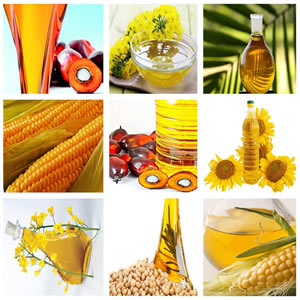Difference between Olive Oil and Vegetable Oil
Key difference: Oils have always been a part of major discussions in the food sciences. Among the various cooking Vegetable oils, which are produced from the nuts, seeds and plant sources, Olive oil is a kind of vegetable oil that is produced from the pressed olive fruits.
Olive oil and vegetable oil are edible oils which are used in several cooking and baking applications. These oils are been in use right from previous years. Vegetable oils in all consists of varieties of oils in itself as a part of whole, these oils are obtained from nuts, herbs, fruits and seeds. Olive oil is also a part of Vegetable oil. Of all the naturally manufactured oils, the olive oil has the largest amount of heart healthy monounsaturated fat. While, suggestions are needed from the experts in order to select any Vegetable oils for cooking, as there are several kinds of vegetable oils in the market.
.jpg) Olive oil is obtained from the mechanical pressing of olives, which is a fruit. The crude oil thus obtained has its own natural and unique flavor, hence is applicable in the cooking and baking methods.
Olive oil is obtained from the mechanical pressing of olives, which is a fruit. The crude oil thus obtained has its own natural and unique flavor, hence is applicable in the cooking and baking methods.
The oil exists in several forms or types, as it is classified according to their extraction processes; the grades are:
- Extra-virgin (regarded to be the best among all its types, as comes from the first pressing of the olives)
- Virgin-(oil does not undergo any refinement)
- Olive oil – (it’s a blend of virgin olive oil and lower-quality refined olive oil)
- Olive Pomace oil – (this is very refined olive oil, obtained from the residue that remains once the oil is pressed)
The olive oil and its types are rich sources of anti-oxidants and mono-unsaturated fats; due to which this oil is applicable in reducing the coronary related issues and problems. The oil also has greater applications in cooking, cosmetics, pharmaceuticals, soaps and as fuel for traditional oil lamps. Also, they are used in human direct consumption on bread, or salads; indirect consumption in domestic cooking and catering, along with the industrial uses such as animal feed or engineering.

Vegetable oils are produced from the basic plant sources like the seeds, fruits and nuts. The most common varieties in vegetable oil include olive oil, soybean oil, corn oil, safflower oil and peanut oil. Vegetable oils are composed of triglycerides, as contrasted with waxes which lack glycerin in their structure.
Vegetable oils can be classified in two particular ways:
- By source: as not all vegetable oils are extracted from the fruits or seeds of plants, and the oils may also be classified by grouping the oils from similar plants, for example: "nut oils".
- By use: these oils from plants are also used in cooking; for fuel, cosmetics, medical purposes, and other industrial purposes.
Virtually, these oils have no taste, hence making them a preferable option in cooking and baking. They are known to overshadow the respective food’s flavor, in which they are used. The source of vegetable oil varies according to the type of oil or crop, and sources include the seed of a fruit and nuts. These oils are consumed directly or indirectly along with the ingredients of food. They also share a particular role along with the animal fats, which includes butter and ghee. Many vegetable oils are used to make soaps, skin products, candles, perfumes and other personal care and cosmetic products. There are issues of toxic and non-toxic nature of vegetable oils; while selecting any type of oils; hence these oils are sometimes not preferred at some duration of time and place.
In comparison, olive oil has low smoke point and hence the oil is used for frying purposes in cooking; while vegetable oils so obtained from various different processes have a higher smoke point and hence these oils are preferred for high temperature cooking. Both the oils are essential in limited quantity in day-to-day life. There are various reasons and issues to use these oils when comes to the cooking applications. Vegetable oils possess a large amount of naturally existing active fats ads their main components. These are Omega-6 polyunsaturated fatty acids, which are harmful when consumed in excess. Hence, depending upon their cooking method or flavors of food, these oils are preferred. The balanced diet requires both the oils, as their essential components are necessary in order to keep an individual’s health fit and fine.
Comparison between Olive Oil and Vegetable Oil:
|
|
Olive Oil |
Vegetable Oil |
|
Obtained from |
olive fruits |
vegetable and plant sources like seeds, nuts and fruits |
|
Types |
extra-virgin, virgin, light/pure, olive, olive pomace oil |
palm oil, soya bean oil, canola oil, pumpkin seed oil, corn oil, sunflower oil, safflower oil, peanut oil, grape seed oil, sesame oil, argan oil, rice bran oil and some others |
|
Fat composition |
14% Saturated Fat and 73% Monounsaturated Fat. |
Coconut oil has the highest content of saturated fat (92%). Canola & sunflower oil have the least amount of saturated fats (6% and 9%, respectively), but contain a higher percentage of monosaturated fat (62% and 82% respectively). |
|
Rich in |
high levels of calcium and iron, vitamins A, C and monounsaturated fatty acids in high levels – natural anti-oxidants |
active fats called Omega-6 polyunsaturated fatty acids |
|
Typical Applications |
|
|
Image Courtesy: agonaskritis.gr, green-indus.com









Add new comment